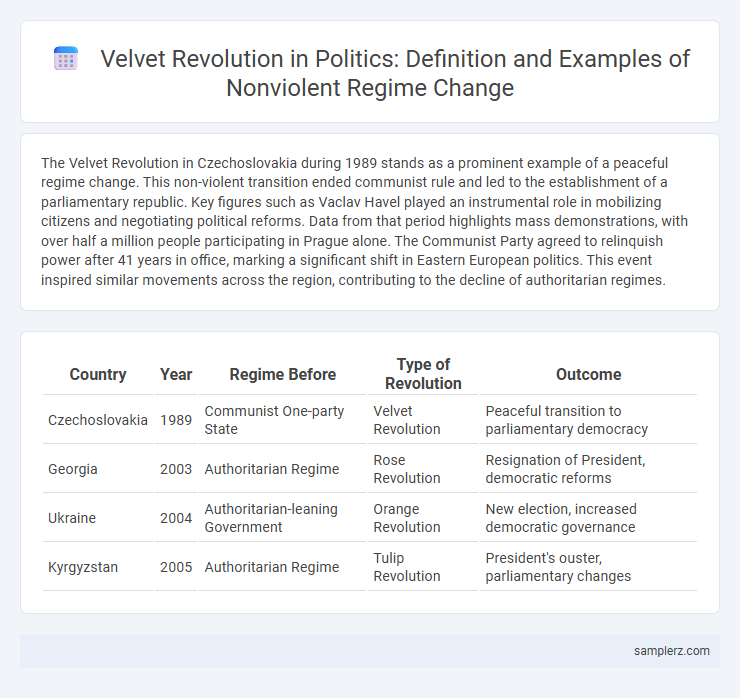The Velvet Revolution in Czechoslovakia during 1989 stands as a prominent example of a peaceful regime change. This non-violent transition ended communist rule and led to the establishment of a parliamentary republic. Key figures such as Vaclav Havel played an instrumental role in mobilizing citizens and negotiating political reforms. Data from that period highlights mass demonstrations, with over half a million people participating in Prague alone. The Communist Party agreed to relinquish power after 41 years in office, marking a significant shift in Eastern European politics. This event inspired similar movements across the region, contributing to the decline of authoritarian regimes.
Table of Comparison
| Country | Year | Regime Before | Type of Revolution | Outcome |
|---|---|---|---|---|
| Czechoslovakia | 1989 | Communist One-party State | Velvet Revolution | Peaceful transition to parliamentary democracy |
| Georgia | 2003 | Authoritarian Regime | Rose Revolution | Resignation of President, democratic reforms |
| Ukraine | 2004 | Authoritarian-leaning Government | Orange Revolution | New election, increased democratic governance |
| Kyrgyzstan | 2005 | Authoritarian Regime | Tulip Revolution | President's ouster, parliamentary changes |
Overview of Velvet Revolutions in Political Regimes
Velvet Revolutions represent non-violent transitions of political regimes characterized by peaceful mass protests and civil resistance against authoritarian governments. The 1989 Velvet Revolution in Czechoslovakia demonstrated how coordinated citizen movements and intellectual leadership can effectively dismantle communist regimes without armed conflict. These revolutions highlight the power of civic unity and strategic activism in achieving democratic reforms and regime changes worldwide.
Defining Characteristics of Velvet Regime Changes
Velvet regime changes are marked by non-violent mass protests, widespread civil disobedience, and a unified opposition demanding democratic reforms. These movements commonly feature the peaceful overthrow of authoritarian governments, with minimal bloodshed and the establishment of transitional governments based on open dialogue. The pivotal roles of intellectuals, students, and media in mobilizing public support and maintaining nonviolent discipline define the effectiveness of velvet revolutions.
Czechoslovakia’s 1989 Velvet Revolution: A Model Example
Czechoslovakia's 1989 Velvet Revolution exemplifies a peaceful transition from communist rule to democracy, marked by mass protests and nonviolent resistance. Key figures like Vaclav Havel emerged as leaders who facilitated the dissolution of the authoritarian regime without armed conflict. The revolution's success inspired similar movements across Eastern Europe, showcasing the power of civic engagement and negotiation in political regime change.
The Baltic Way: Peaceful Protest and Regime Shift
The Baltic Way, a massive peaceful protest on August 23, 1989, saw approximately two million people forming a human chain across Estonia, Latvia, and Lithuania, symbolizing unity and demanding independence from Soviet rule. This nonviolent demonstration played a crucial role in weakening the Soviet regime's grip and inspired similar movements throughout Eastern Europe. The success of the Baltic Way contributed significantly to the eventual restoration of independence for the Baltic states, marking a pivotal moment in the broader Velvet Revolution that reshaped post-Cold War politics.
Georgia’s Rose Revolution and Its Political Impact
Georgia's Rose Revolution in 2003 was a pivotal non-violent uprising that ended Eduard Shevardnadze's authoritarian regime and initiated democratic reforms. The revolution catalyzed significant political changes, including a revamped constitution and increased transparency, positioning Georgia as a regional model for democratic transitions. This peaceful transfer of power reinforced civil society's role in governance and strengthened Western integration efforts through NATO and EU aspirations.
Armenia’s 2018 Velvet Revolution and Democratic Transition
Armenia's 2018 Velvet Revolution exemplified a peaceful regime change driven by mass protests against corruption and authoritarianism, resulting in the resignation of Prime Minister Serzh Sargsyan. This nonviolent movement led to the election of Nikol Pashinyan, marking a successful democratic transition and renewed commitment to transparency and rule of law. The revolution showcased the power of civil society and digital organization in reshaping post-Soviet political landscapes.
Key Factors Influencing Velvet Regime Change
The Velvet Revolution in Czechoslovakia was driven by key factors including widespread public dissatisfaction with communist authoritarian rule, economic stagnation, and a strong civic push for democratic reforms. The strategic role of non-violent protests led by intellectuals and students, supported by international pressure from Western democracies, significantly accelerated the regime change. Crucial to the transition was the unified opposition coalition, which capitalized on media coverage and public sentiment to dismantle the existing political structure peacefully.
Strategic Nonviolence in Peaceful Political Transitions
The Velvet Revolution of 1989 in Czechoslovakia exemplifies strategic nonviolence in peaceful political transitions, where mass protests, coordinated strikes, and civil resistance led to the dismantling of communist rule without armed conflict. Key figures like Vaclav Havel utilized nonviolent tactics to unify opposition groups and engage international support, demonstrating the power of disciplined, peaceful action. This revolution highlighted how strategic nonviolence can effectively challenge authoritarian regimes and facilitate democratic change.
International Influence on Velvet Revolutions
The Velvet Revolution of 1989 in Czechoslovakia was significantly influenced by international support, particularly from Western governments and media that amplified the call for democratic reforms. The success of earlier peaceful protests in Poland and Hungary provided a regional model that inspired activists and pressured the communist regime to negotiate. NATO and the European Community also played indirect roles by promoting the values of human rights and political pluralism, helping to create an environment conducive to peaceful transitions.
Lasting Legacies of Velvet Revolutions in Modern Politics
Velvet Revolutions, such as the 1989 Czechoslovak transition, established a blueprint for non-violent regime change that prioritized civil liberties and democratic governance. These peaceful uprisings demonstrated the power of mass mobilization and strategic dialogue, influencing subsequent democratic movements worldwide. Their lasting legacies include the solidification of parliamentary democracies and the promotion of human rights norms in post-authoritarian states.

example of velvet revolution in regime Infographic
 samplerz.com
samplerz.com